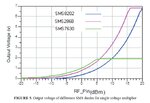vlinh96
Newbie level 4
Hello everyone,
I'm an EE student and I'm having a project about the rectenna at 2.45 GHz and -10 dBm.
My rectifier uses SMS 7630-079 LF from Skyworks as the diode for the circuit and the load of rectifier is fixed at 10 kOhm. I measured its S-parameters and the circuit is well-adapted at 2.45 GHz. However, when I measured the DC rectified voltage, I had nothing at all. Meanwhile, in ADS simulation, I could get 0.7 V for DC voltage.
Could you tell me why my circuit didn't work ? Do we have some problem with the ground or not ?
Thank you for your help.
P/S : I'm a newbie in this section.
I'm an EE student and I'm having a project about the rectenna at 2.45 GHz and -10 dBm.
My rectifier uses SMS 7630-079 LF from Skyworks as the diode for the circuit and the load of rectifier is fixed at 10 kOhm. I measured its S-parameters and the circuit is well-adapted at 2.45 GHz. However, when I measured the DC rectified voltage, I had nothing at all. Meanwhile, in ADS simulation, I could get 0.7 V for DC voltage.
Could you tell me why my circuit didn't work ? Do we have some problem with the ground or not ?
Thank you for your help.
P/S : I'm a newbie in this section.

